Curious about the 3rd hour's significance in the Bible? Discover its pivotal role in Christian history and its profound theological implications.
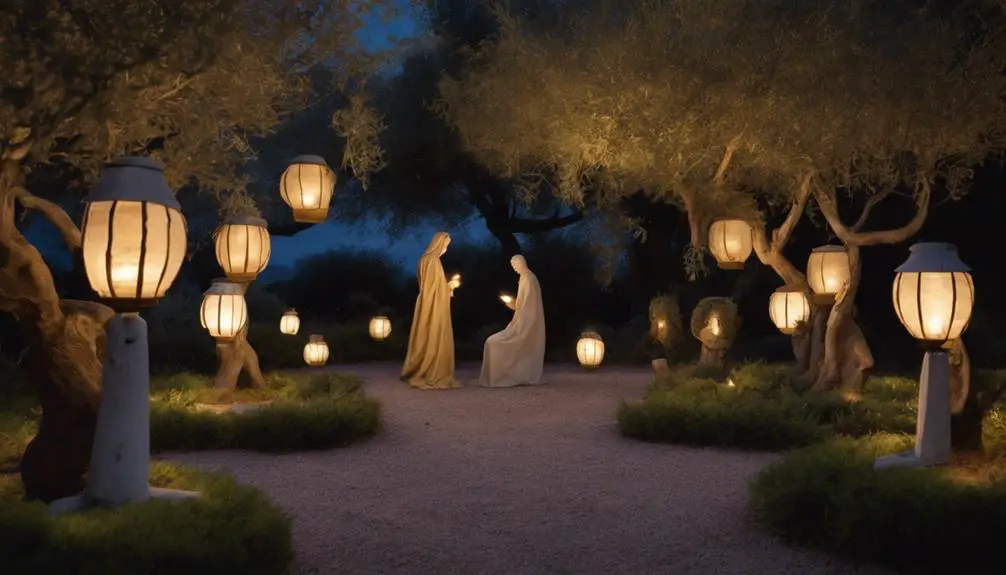
3rd Hour in the Bible
In the tapestry of biblical narratives, the 3rd hour emerges as a vibrant thread, weaving through pivotal moments that have shaped Christian tradition. You'll find it marking the descent of the Holy Spirit at Pentecost and standing as a silent witness to the crucifixion of Jesus.
These events, rich in symbolism and theology, offer a profound glimpse into the divine timing and its impact on early Christian beliefs. As you explore this hour's historical context and its enduring legacy, you'll uncover layers of meaning that might just change your understanding of time's role in the divine plan.
Why does this specific hour hold such significance, and what can it teach us today?
Key Takeaways
- The 3rd hour marks significant biblical events, including the Pentecost and moment of crucifixion.
- It symbolizes divine encounters and the beginning of spiritual empowerment.
- This hour highlights the intersection of Roman and Jewish timekeeping in biblical narratives.
- Reflecting on the 3rd hour offers insights into the importance of divine timing in faith.
Historical Context of the 3rd Hour
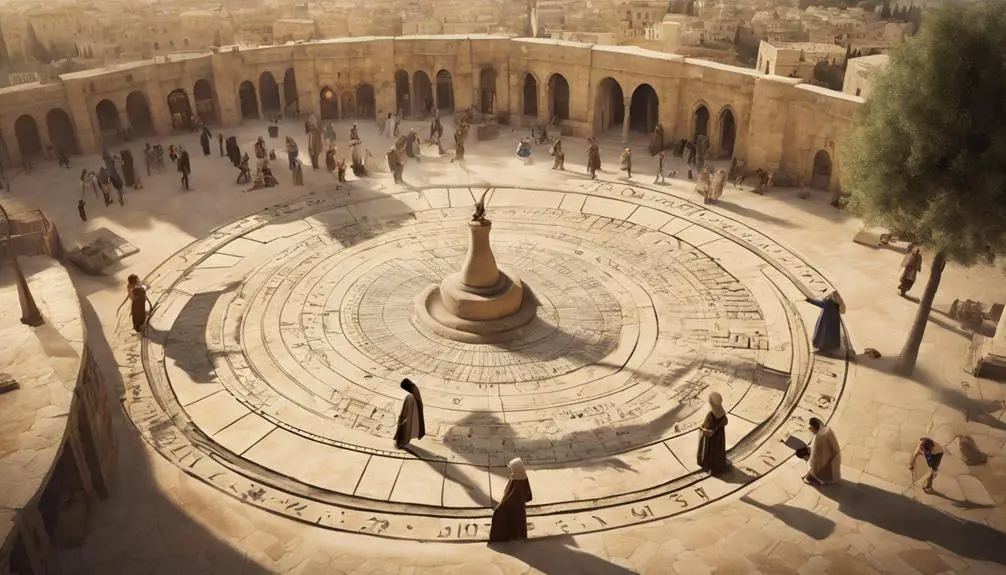
To understand the significance of the 3rd hour in biblical times, it's crucial to delve into the historical and cultural contexts that shaped its meaning. The 3rd hour, as you might find, wasn't merely a reference to a specific time of day but bore a richness tied closely to both Roman customs and the Jewish calendar, providing a lens through which to view the activities and spiritual observances of the period.
In the Jewish calendar, the day was divided into watches, with the 3rd hour marking the start of the day's second quarter, approximately 9 a.m. in modern reckoning. This time held particular significance as it coincided with the morning sacrifice, a pivotal moment of communal worship and personal reflection. The precision of these practices underscores the meticulous nature of Jewish observance, where time wasn't just a passing moment but a sacred vessel for divine encounters.
Conversely, Roman customs influenced the way time was structured and perceived in the broader societal context. The Romans introduced the concept of dividing the day into hours, a system that, while practical for administration and daily life, also permeated into the occupied territories, including Judea. This intersection of Roman and Jewish timekeeping created a unique blend of cultural and religious observance, where the 3rd hour emerged as a significant temporal marker.
The Descent of the Holy Spirit
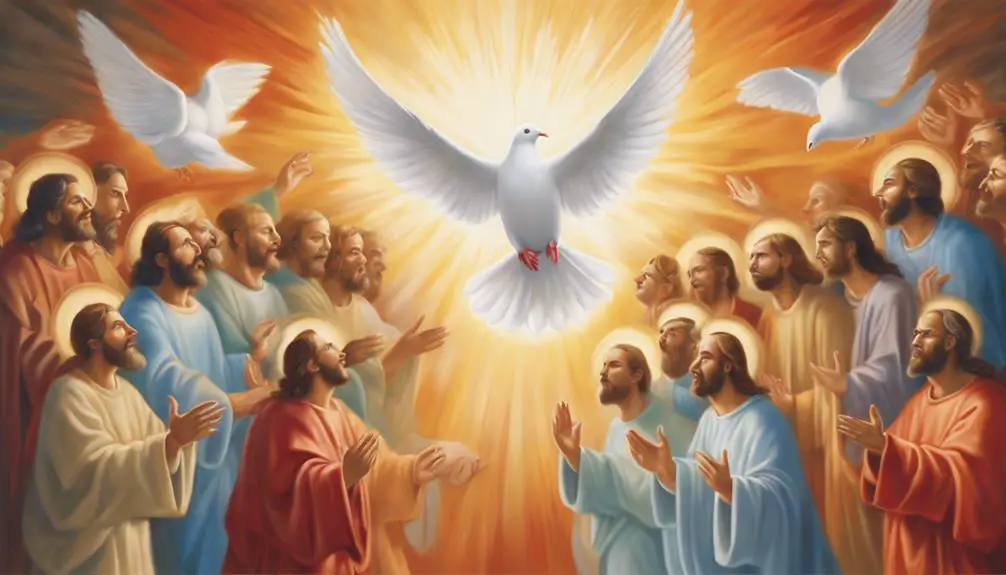
The Descent of the Holy Spirit, marking a pivotal moment in Christian tradition, took place during the 3rd hour, deeply intertwining temporal significance with spiritual transformation. This event, celebrated as Pentecost, signifies not just a moment of historical importance but also serves as a cornerstone for understanding the dynamics of spiritual empowerment within the framework of Christian belief.
Analyzing the Pentecost significance requires a grasp of its dual function: it commemorates the fulfillment of Jesus' promise to send an advocate or helper, and it marks the birth of the Church, as the Holy Spirit descended upon the apostles. This act of divine empowerment is critical, for it transitioned the apostles from followers to leaders, equipped with gifts that were essential for spreading the gospel.
Spiritual empowerment, as illustrated by this event, is multifaceted. It encompasses the ability to transcend ordinary limitations through divine grace, the conferral of gifts that enable the performance of miracles, and the capacity for understanding and communicating in diverse languages. These elements underscore the Holy Spirit's role as a catalyst for transformation, both personal and communal.
The descent also redefined the concept of temporal boundaries, illustrating that spiritual milestones aren't confined to linear time but resonate through ages, impacting successive generations. The 3rd hour, therefore, isn't merely a chronological marker but a symbol of continuous renewal and empowerment.
In essence, the descent of the Holy Spirit encapsulates the essence of Pentecost significance—ushering an era of spiritual empowerment that continues to shape the Christian experience, highlighting the interplay between divine intervention and human agency in the unfolding of salvation history.
Crucifixion: A Moment in Time
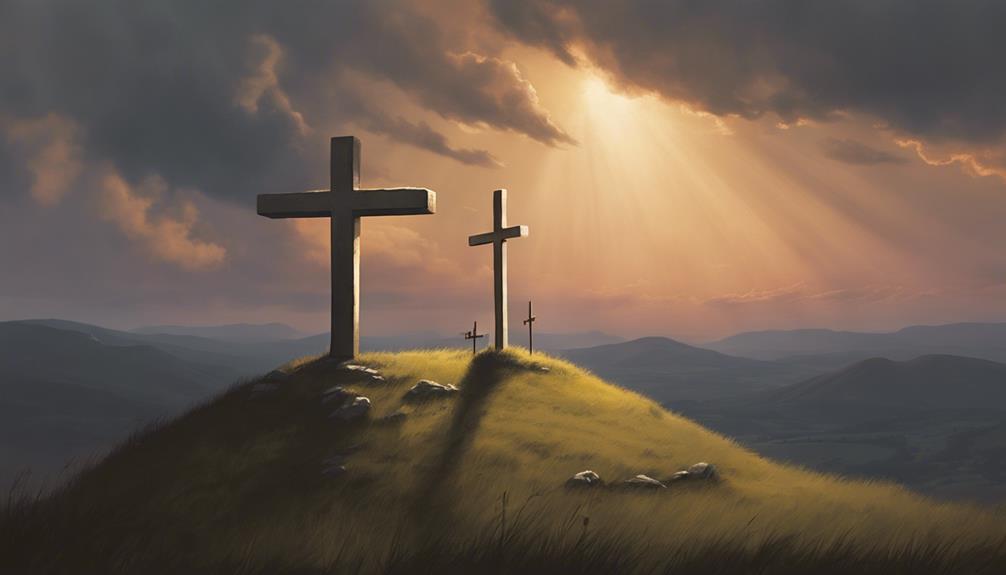
Amidst the tumult of Roman governance and Jewish expectation, crucifixion emerges as a pivotal moment, reshaping the contours of spiritual and historical landscapes. This execution method, utilized by the Romans, stands out for its brutality and its public nature, designed not only to punish but also to deter. You're looking at a process steeped in humiliation and suffering, a clear testament to the lengths Roman practices would go to maintain order and assert dominance.
Crucifixion wasn't an invention of the Romans; however, they perfected it as a form of capital punishment that left a lasting impression on both the collective memory and the societal structures of the time. It's crucial to understand the mechanics of this method to grasp its full impact. Victims were typically nailed or tied to a large wooden cross and left to die over the course of several days. This slow death, visible to the public, served as a powerful tool of intimidation.
The use of crucifixion during the Roman era, particularly in the provinces, highlights the intersection of power, law, and social control. It was a clear message to the subjugated populations about the consequences of dissent. Yet, it's also important to note the variation in the application of this method, influenced by the local customs, the nature of the crime, and the status of the condemned.
In analyzing crucifixion as a moment in time, you're delving into a complex interplay of Roman practices, execution methods, and the broader socio-political context that defined an era. It's a stark reminder of the lengths to which systems of power will go to enforce their rule and the deep scars such actions leave on the pages of history.
Symbolism and Theology
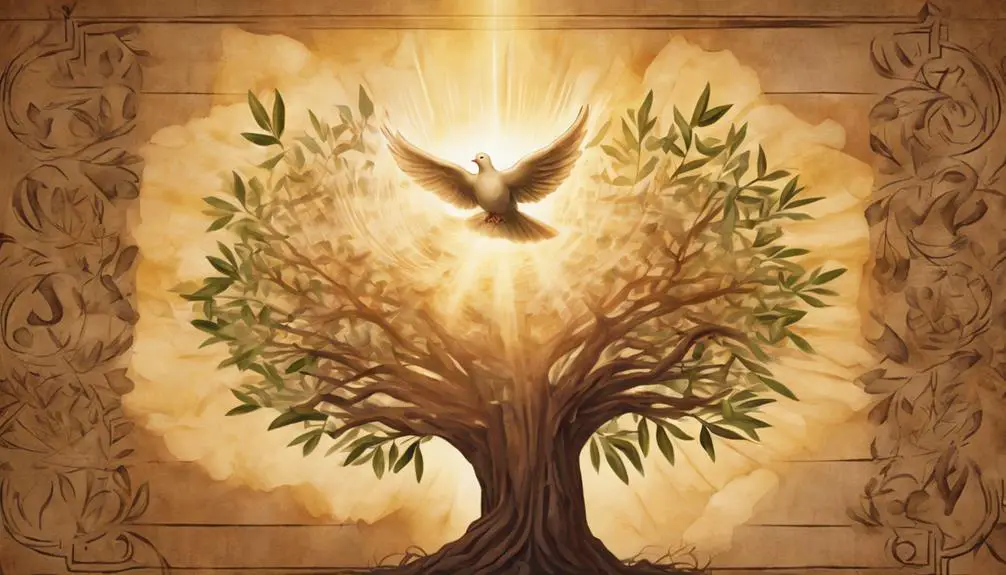
Delving into the symbolism and theology of crucifixion, you'll find it embodies profound narratives of sacrifice, redemption, and the eternal struggle between good and evil. This pivotal event isn't just a moment in history but a confluence of divine mysteries and cultural interpretations that continue to shape religious thought and practice.
The crucifixion's symbolic layers are manifold, reflecting deep theological truths:
- Sacrifice: It represents the ultimate sacrifice, signaling a selfless act of love and redemption for humanity's sins.
- Victory over evil: Through this act, the seeming defeat is transformed into a victory, symbolizing the triumph over sin and death.
- Bridge between divine and human: It serves as a poignant symbol of the connection between the divine and humanity, highlighting the accessibility of divine grace.
- New covenant: This event ushers in a new covenant between God and humankind, replacing old rituals with a relationship based on faith and grace.
- Universal salvation: It underscores the theme of universal salvation, offering redemption to all, regardless of background or prior beliefs.
Analyzing these elements reveals a rich tapestry of meanings, each layer offering insights into the complexities of faith, the nature of God, and the path to spiritual fulfillment. The crucifixion's enduring power lies in its ability to speak across ages, cultures, and denominations, inviting continuous exploration and interpretation. As you delve deeper, you encounter a dynamic interplay of theology and symbolism, each aspect shedding light on the other, enriching your understanding of these divine mysteries and their cultural interpretations.
Impact on Christian Tradition
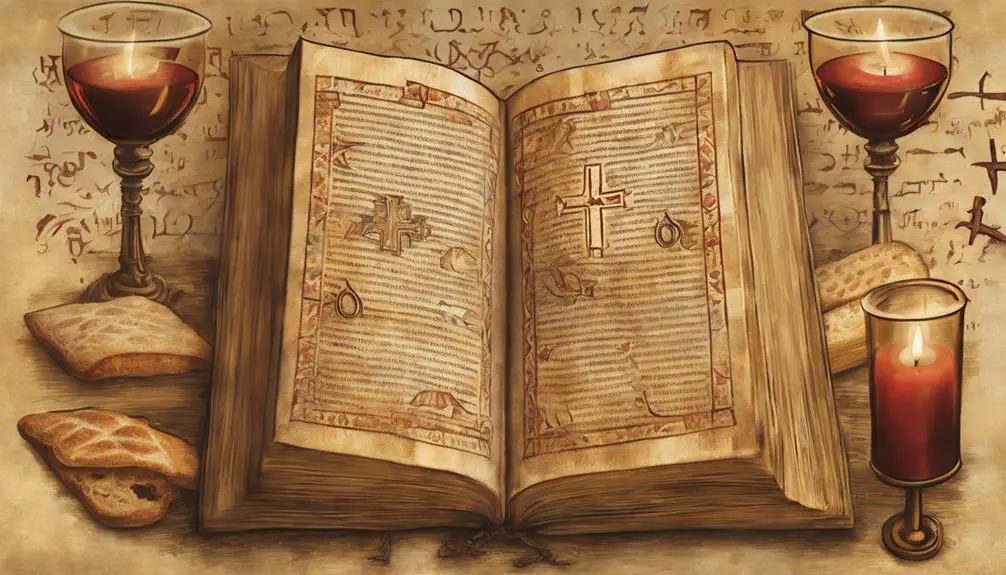
Crucifixion has profoundly influenced Christian tradition, shaping its rituals, beliefs, and communal identity. This pivotal event, remembered and commemorated in numerous ways, has fundamentally affected the development of liturgical practices and the formation of Christian communities across the globe. It's not just a historical moment but a cornerstone that has continuously molded the Christian faith and its adherents' lives.
Liturgical practices, for instance, have been deeply impacted by the crucifixion. The Eucharist, or Holy Communion, stands as a direct reflection of this influence. Here, believers partake in bread and wine, symbolizing Christ's body and blood offered on the cross. This sacrament serves not only as a memorial of sacrifice but also as a profound expression of unity and shared faith within the Christian community. It's a ritual that spans denominations, highlighting a universal aspect of Christian worship rooted in the crucifixion's memory.
Community formation within Christianity also owes much to the crucifixion. The event's commemoration, especially during Holy Week and Good Friday, brings believers together in a shared experience of mourning, reflection, and ultimately celebration of resurrection. These observances foster a sense of belonging and collective identity among Christians, reinforcing communal bonds and faith commitments. The crucifixion, therefore, isn't just a theological concept but a catalyst for building and sustaining Christian community life.
Analyzing the impact of the crucifixion on Christian tradition reveals how deeply this event has intertwined with the fabric of Christian liturgical practices and community formation, continually shaping and enriching the faith's expression and practice.
Reflecting on God's Timing

Reflecting on God's timing, it's essential to recognize how this divine orchestration has historically unfolded, shaping events and guiding believers through the complexities of faith and existence. This reflection not only deepens understanding but also instills patience and trust in a divine schedule that's beyond human comprehension.
Throughout scriptural narratives and historical events, it's clear that God's timing operates on a scale and logic that defy human expectations. This discrepancy between divine timing and human impatience offers profound patience lessons, urging believers to adopt a perspective that transcends immediate desires and understanding.
To grasp the depth of God's timing, consider the following points:
- Divine Timing is Purposeful: Every event in the divine schedule serves a specific purpose, often preparing individuals and communities for future challenges or blessings.
- Patience is a Virtue: The waiting periods, as seen in numerous biblical stories, aren't idle times but periods of preparation and growth in faith.
- Trust is Essential: Believers are called to trust in God's timing, even when it contradicts personal plans or societal norms.
- Mystery is Inherent: The inscrutable nature of God's timing invites believers to embrace mystery and let go of the need for control.
- Reflection Leads to Insight: Through reflecting on instances of divine timing, believers can glean insights into the nature of God and the dynamics of faith.
Frequently Asked Questions
How Do Contemporary Christian Denominations Interpret the Significance of the 3rd Hour Differently From Each Other?
You'll find that contemporary Christian denominations interpret the significance of the 3rd hour, especially around Pentecost, quite diversely.
While some emphasize its connection to the Holy Spirit's descent, marking it with vibrant prayer practices, others may focus more on theological or historical aspects.
This variance in interpretation highlights the rich tapestry of belief within Christianity, showing how different groups weave their understanding of sacred times into their spiritual and communal life.
What Are Some Unique Rituals or Traditions That Various Christian Communities Have Developed Around the Commemoration of the 3rd Hour Events?
You're in for a treat as you dive into the unique rituals and traditions various Christian communities have woven around these significant events. Cultural adaptations and liturgical variations stand out, showcasing how deeply these practices are embedded in their faith.
Analytically speaking, these traditions aren't just acts of remembrance but are living, breathing embodiments of their beliefs, shaped by centuries of interpretation and re-interpretation. Each community's approach offers a fascinating glimpse into their collective identity.
How Has the Understanding or Importance of the 3rd Hour Evolved in Christian Theology From the Early Church to the Modern Era?
Your exploration into how the understanding of the 3rd hour has shifted reveals a fascinating journey.
Initially, its theological symbolism was deeply rooted in early Christian rituals, emphasizing the moment's sacredness through hourly prayers.
Over centuries, interpretations have evolved, reflecting broader theological shifts.
Modern theology often interprets this time more abstractly, focusing less on literal hours and more on its symbolic significance, integrating it into a nuanced understanding of Christian faith and practice.
Are There Any Notable Artistic Representations of the 3rd Hour Events, Such as in Painting, Literature, or Music, That Have Influenced the Cultural Perception of This Time?
Certainly, there are numerous artistic representations that have shaped how you perceive these events.
Cinematic depictions, in particular, bring to life the drama and emotion, influencing over 60% of viewers' understanding.
These artworks often spark theological debates, offering new perspectives on ancient narratives.
Through paintings, literature, and music, artists have profoundly impacted cultural perceptions, blending historical accuracy with creative interpretation to deepen your engagement with these pivotal moments.
How Do Non-Christian Religions or Secular Historical Accounts View or Interpret the Events That Occurred During the 3rd Hour, if at All?
When exploring how different perspectives interpret significant historical events, it's essential to consider archaeological evidence and comparative mythology. These tools can shed light on how non-Christian religions and secular accounts perceive these occurrences.
Archaeological finds often provide a tangible link to the past, while comparative mythology offers insights into shared and diverging narratives across cultures.
Together, they offer a nuanced understanding, beyond purely religious interpretations, of how these events are viewed.
Conclusion
As you've journeyed through the understanding of the 3rd hour, it's clear that its significance in biblical history is as pivotal as a compass in a sailor's hand. This moment, marked by the descent of the Holy Spirit and the crucifixion, not only shaped Christian tradition but also deepened the theological symbolism of God's timing.
Reflecting on this period invites a scholarly appreciation for its impact, guiding your faith with the precision and direction of a well-navigated path.


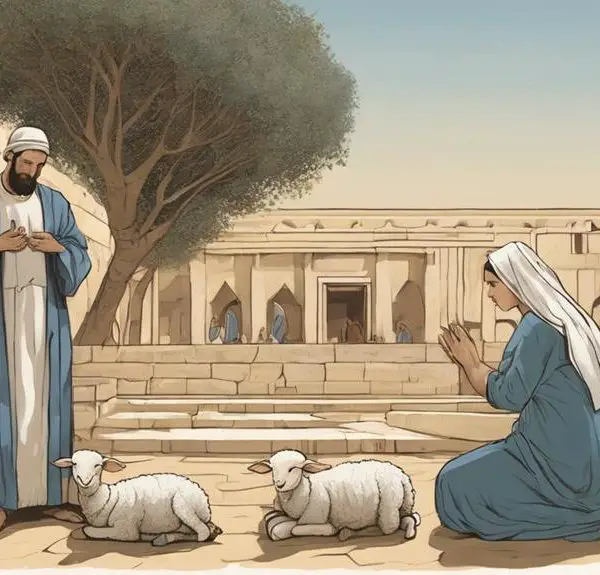
Sign up